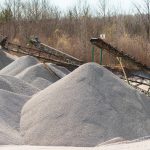Building a house is a significant investment, if not THE most significant investment you will ever make, and ensuring that the foundation it is built on is strong and stable is crucial to the build’s longevity and your safety. One of the most critical components of a structurally sound foundation is the soil it’s built upon. That’s why residential soil testing is an essential step in any building project. In this article, we’ll discuss what residential soil testing involves and why it’s crucial to get it right.
What is Residential Soil Testing?
Residential soil testing is a process of analysing the soil on a site where a house is to be built. The testing helps to determine the soil’s composition, strength, and load-bearing capacity, which is essential to ensure that the foundation can support the weight of the house and prevent damage from soil movements.
The testing involves collecting soil samples from different depths and testing them for their physical properties. The tests are carried out on-site and in the laboratory, and the results are compiled to determine the site classification. The site classification value is a classification system used to determine the suitability of the soil for building a house and to design the appropriate foundation for the site.
Why is Residential Soil Testing Important?
There are several reasons why soil testing is essential when building a house.
Safety: The most important reason to get soil testing right is safety. A weak foundation can lead to structural damage, which can compromise the safety of the occupants of the house. Soil testing helps to ensure that the foundation is designed strong enough to support the weight of the house and prevent soil movements that could cause damage.
Cost Savings: Conducting soil testing can help to identify potential issues with the soil before construction begins. This can help to prevent costly mistakes, such as foundation failure, and minimise the need for expensive repairs and maintenance in the future. If the soil test is inaccurate, the site classification may be inaccurate, meaning it could raise the risk of foundation cracking, brick and gyprock cracking, and frame movement. Conversely, an inaccurate soil test could mean your site classification value is much higher than required, meaning the cost of your build could be much higher than needed. As a result, it’s vital to choose a reputable company that provides reliable results.
Compliance with local Councils and Building Codes: Building codes require that houses are built on suitable soil conditions. Conducting residential soil testing is necessary to ensure that the foundation meets the requirements of the building code and to obtain the necessary permits for construction. In Australia, sites are classified in accordance with Australian Standard AS2870.
Optimal Foundation Design: Soil test results are used by engineers to design the appropriate foundation system for the house. The foundation design is utilised by your builder and concreters to ascertain the cost of materials and the construction necessities onsite. The foundation design must consider the soil’s load-bearing capacity, drainage, and stability to ensure that the foundation is stable and durable. This will help to ensure that the house is built on a solid foundation that will last for many years.
What Does Residential Soil Testing Involve?
Soil testing for residential builds involves several stages, including:
Site Inspection: A site inspection is carried out to identify any potential issues that could affect the soil’s suitability for building. This may include factors such as slope, drainage, and vegetation cover.
Soil Sampling: Boreholes are drilled, and soil samples are collected from different depths and locations on the property. The number of samples collected depends on the size of the property and the complexity of the site. The samples are then taken back to the laboratory for analysis.
On-Site Testing: While inspecting the site and collecting samples a Dynamic Cone Penetrometer (DCP) test is undertaken as part of the process of determining the underlying soil strength.
Laboratory Testing: The soil samples are taken back to the laboratory and are analysed for their physical properties, including the liquid limit (moisture content where the soil starts to behave as a liquid) and plastic limit (moisture content at which soil begins to behave as a plastic material).
Site Classification Report: The soil test results are compiled into a report, in which the ‘characteristic surface movement’ (Ys value) is calculated. This determines the class of the Site Classification in accordance with AS2870-2011. The report is provided to the builder or engineer so the foundation can be designed appropriately for the soil conditions.
In summary, residential soil testing is an essential step in any building project. It helps to ensure that the foundation is strong, stable, and safe, and minimises the risk of costly mistakes and repairs in the future. If you’re building a house, make sure that you engage a reputable soil testing company to conduct the soil testing and provide the site classification report. This will help to ensure that your new home is built on a solid foundation that will stand the test of time.
At Geotechnical Services, our regional network of experienced Drillers and Technicians possess extensive drilling and testing expertise as well as expert knowledge of the soil conditions and characteristics of the regions in which they operate. Testing is conducted in our NATA Accredited laboratories (not all soil testing laboratories are accredited, so it is important to check this when choosing a company for your site classification).
Contact our team here if you’d like more information or click here to request a quote.




